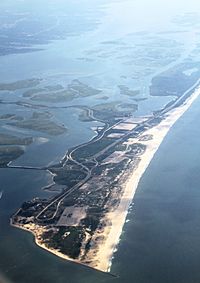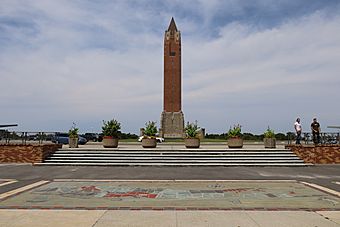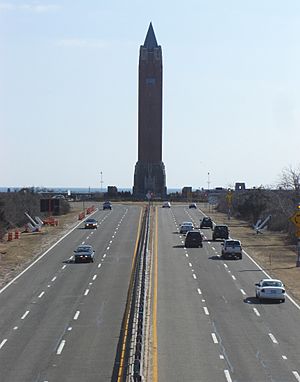Jones Beach State Park facts for kids
Quick facts for kids Jones Beach State Park |
|
|---|---|

Aerial view of Jones Beach Island and Jones Beach State Park in July 2012
|
|
| Type | State park |
| Location | 1 Ocean Parkway Wantagh, New York, U.S. |
| Area | 2,413 acres (9.77 km2) |
| Created | August 4, 1929 |
| Operated by | New York State Office of Parks, Recreation and Historic Preservation |
| Visitors | 8,313,133 (in 2020) |
| Open | All year |
| Public transit access | |
| Website | Jones Beach State Park |
|
Jones Beach State Park, Causeway and Parkway System
|
|

Jones Beach Water Tower in 2021
|
|
| Location | Ocean, Wantagh, Meadowbrook and Loop state parkways, Wantagh, New York |
| Area | 10,034 acres (4,061 ha) |
| NRHP reference No. | 05000358 |
| Added to NRHP | April 28, 2005 |
Jones Beach State Park, often called "Jones Beach", is a famous state park in New York. It's located on Jones Beach Island, which is a long, thin island called a barrier island. This island is connected to Long Island by several roads.
The park is about 6.5 miles (10.5 km) long. It's known for its amazing beaches that face the Atlantic Ocean. Jones Beach is one of the most popular summer spots for people living in the New York metropolitan area. About six million people visit it each year, making it the most visited beach on the East Coast.
Inside the park, you'll find the Northwell Health at Jones Beach Theater. This is a cool outdoor place where you can watch musicals and concerts. The park also has a two-mile (3.2 km) long boardwalk where you can walk and enjoy the ocean air.
Jones Beach gets its name from Major Thomas Jones. He was a military leader in the 1600s who set up a whaling station near where the park is today.
History of Jones Beach
Building a Beach for Everyone
Jones Beach was the first big project led by Robert Moses. He wanted to create a public park that everyone could enjoy, unlike private clubs or housing areas. To make space for the park, some homes on High Hill Beach were moved to another part of the island.
When Moses' team first looked at Jones Island, it was mostly swampy land. It was only about two feet (0.61 m) above sea level and often went underwater during storms. To build the park, huge machines called dredgers brought sand from the bottom of the bay. This raised the island to 12 feet (3.7 m) above sea level.
Stopping the Sand from Blowing Away
After raising the island, another problem appeared: the fine beach sand would blow everywhere. This made it hard for workers and would make the beach unpleasant for visitors. Moses sent experts to other beaches to find a solution. They discovered that a special type of beach grass, called Ammophila breviligulata, could hold the sand in place. Its roots grow sideways and form a barrier against the wind. In 1928, thousands of workers planted this grass by hand all over the beach.
Art Deco Buildings and Design
Many of the buildings at Jones Beach were built in the 1920s. They feature a cool style called Art Deco architecture. In the middle of a large traffic circle, Moses had an Italianate-style water tower built. This tower became a central landmark for the park.
Two large bathhouses are also important buildings in the park. Robert Moses chose the designs for these bathhouses from a young architect named Herbert Magoon. He also picked expensive building materials like Ohio Sandstone and Barbizon brick.
Opening Day and Early Rules
Jones Beach officially opened to the public on August 4, 1929. At the same time, a causeway was opened, allowing cars to reach the park from Long Island. This causeway was the first part of what became the Wantagh State Parkway. It was unusual for the time because no carnival rides or amusements were allowed in the park.
Some bridges on the Southern State Parkway, a main road to Jones Beach, were built with lower clearances. This design meant that taller vehicles, like some public buses, might have trouble passing under them.
Air Show and Historic Status
Since 2004, Jones Beach has hosted the Bethpage Air Show every year around Memorial Day weekend. It's one of the biggest air shows in the United States, attracting hundreds of thousands of people.
On April 28, 2005, Jones Beach State Park and its connecting roads were added to the National Register of Historic Places. This means they are recognized as important historical sites.
Park Features and Fun Activities
Ocean and Bay Beaches
The park has 6.5 miles (10.5 km) of ocean beach where you can swim and sunbathe. There's also a one-half mile (0.80 km) long beach along Zachs Bay, which is calmer.
Buildings and Entertainment Spots
The main buildings at Jones Beach are the two bathhouses (West and East) and the tall water tower. The 188-foot (57 m) water tower was built in 1930. It looks a lot like the famous bell tower of St Mark's Basilica in Venice, Italy. It was restored in 2010.
Originally, Jones Beach had two swimming pools, one at each bathhouse. The West Bath House pool is still open, but the East Bath House pool closed in 2009 due to budget reasons. There are plans to improve the West Bath House and eventually fix up the East Bath House too.
You can also see large mosaics on the Central Mall Walkway near the water tower. These beautiful artworks were restored in 2015.
The park also has the Jones Beach Boardwalk Bandshell. It's located near Parking Field 4 and offers live performances and free music shows.
North of the beach, overlooking Zachs Bay, is the 15,200-seat Northwell Health at Jones Beach Theater. This outdoor amphitheatre opened in 1952 and is a popular spot for concerts.
Places to Eat
You'll find many places to grab a snack or a meal along the boardwalk during the summer. Some of the bigger food stands stay open even after the main summer season ends.
There used to be a large restaurant called The Boardwalk Cafe, but it was damaged by erosion and taken down. However, new dining options have opened! Gatsby's is a restaurant and event venue that opened in 2019. The Boardwalk Cafe restaurant also reopened in 2018. You can also find a boardwalk bar and a small gelato stand.
Parking Areas
Jones Beach has several large parking fields. West End 2 is at the very western end of the park, near the water. It's a popular spot for surfing, stargazing, fishing, and bird watching. The Theodore Roosevelt Nature Center, which was once at West End 1, has been replaced by a new Energy & Nature center at West End 2.
During the COVID-19 pandemic, a drive-thru testing site was set up in the West End 1 parking field. This meant the area was closed for other activities for a while.
Getting to Jones Beach
You can reach Jones Beach by car, boat, or bicycle. In the summer, you can also take a bus. Most visitors drive using the Meadowbrook State Parkway or the Wantagh State Parkway. The Ocean Parkway also leads to the park.
Many people also take the Long Island Rail Road (LIRR) to Freeport. From there, they can catch the Nassau Inter-County Express (NICE bus) n88X bus directly to Jones Beach.








